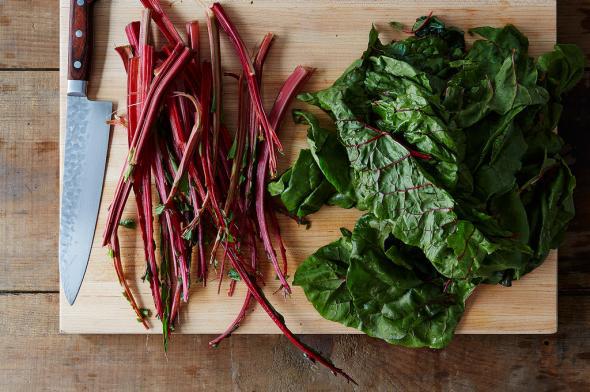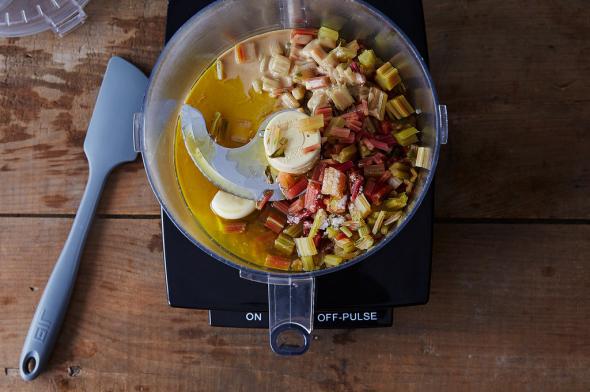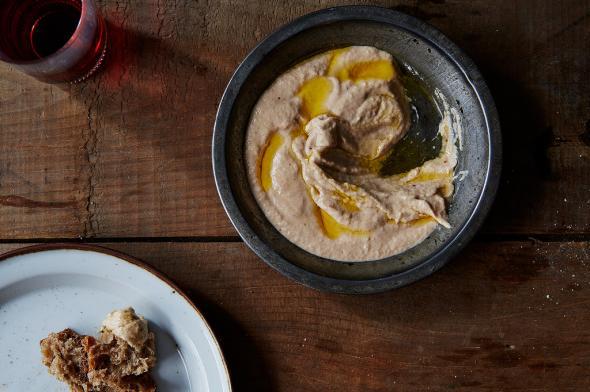This post originally appeared on Food52.
To make the most ethereal hummus, first, you must not make hummus.
Technically, because there are no chickpeas, this is only a close cousin, but it has all the star players that make hummus irresistible—bright lemon on smoky tahini on fiery garlic on tides of olive oil, swelling together. Only the medium is different.
The medium, in this case, is the Swiss chard stems we’re always instructed to strip away when cooking the dark, leafy greens—though next time, the medium could certainly be something else (say, beets). Though this recipe was inspired by ones from Paula Wolfert and Clifford Wright, there’s a whole family of “Mediterranean vegetable spreads that start with a roasted, grilled, or boiled vegetable and add tahini, garlic, olive oil, and lemon,” author Tara Duggan told me. “I’ve made a delicious version with roasted turnips, and of course there’s babaganoush.”
But Duggan decided to call this recipe hummus in her book Root to Stalk Cooking anyway, to make it more recognizable to American cooks, and to widen our understanding of the classic spread. And, perhaps, to make chard stalks—a real underdog in the kitchen—a little friendlier.

Photo by Alpha Smoot
Yes, this recipe is a smart way to minimize wasted kitchen scraps, but unlike other waste-not recipes like asparagus nub soup or strawberry top water, there’s no need to obscure or strain out any offending texture. Somehow, despite everything we know about chard stalks, the results are actually the better for it.
Usually we discard stems and other scrappy bits because they’re fibrous or tough—their unforgiving nature is a hassle we don’t always want to deal with (or perhaps we don’t even know how). And that’s generally true of chard stems, which can be stringy or watery or both. You can pickle, sauté, or grill them, but if you aren’t in the mood (or don’t love the results), you’re unlikely to bother.
So, no offense to stalks, but you need something that’s going to be worth the effort—and extra points if it requires hardly any.
Enter this hummus (“hummus”). Here’s all it takes: Chop the stems, boil them till tender (roughly 18 minutes), blend with all five other ingredients at once. Any strings have surrendered in the boiling; any wateriness emulsifies in to lighten the dip. Depending on the color of the stems, it will come out anywhere from Pepto Bismol to mauve to khaki.

Photo by Alpha Smoot
It spins up fluffy and warm, and goes really well with toasted focaccia and grain salads and hard-cooked eggs. Incidentally, it will also work nicely with the greens that you’ll now be looking for ways to use up.
Tara Duggan’s Chard Stalk Hummus
Adapted slightly from Root to Stalk Cooking
Makes 1 cup
Chard stalks from 1 pound whole chard, trimmed and chopped
1 whole clove garlic, peeled
¼ cup tahini
¼ cup extra-virgin olive oil, plus more for drizzling
2 tablespoons fresh lemon juice
½ teaspoon kosher salt
See the full recipe at Food52.
Got a genius recipe to share—from a classic cookbook, an online source, or anywhere, really? Please send it my way (and tell me what’s so smart about it) at kristen@food52.com. Thanks to Riddley Gemperlein-Schirm for this one!
More from Food52:
A Genius Caesar Salad From a Genius Dad
Yotam Ottolenghi and Sami Tamimi’s Basic Hummus
Hummus’ Spunky Sister: Lemony White Bean Dip With Herbs
How to Make Hummus Without a Recipe
Homemade Tahini, Creamy and Coarse
Let Them Eat Hummus
